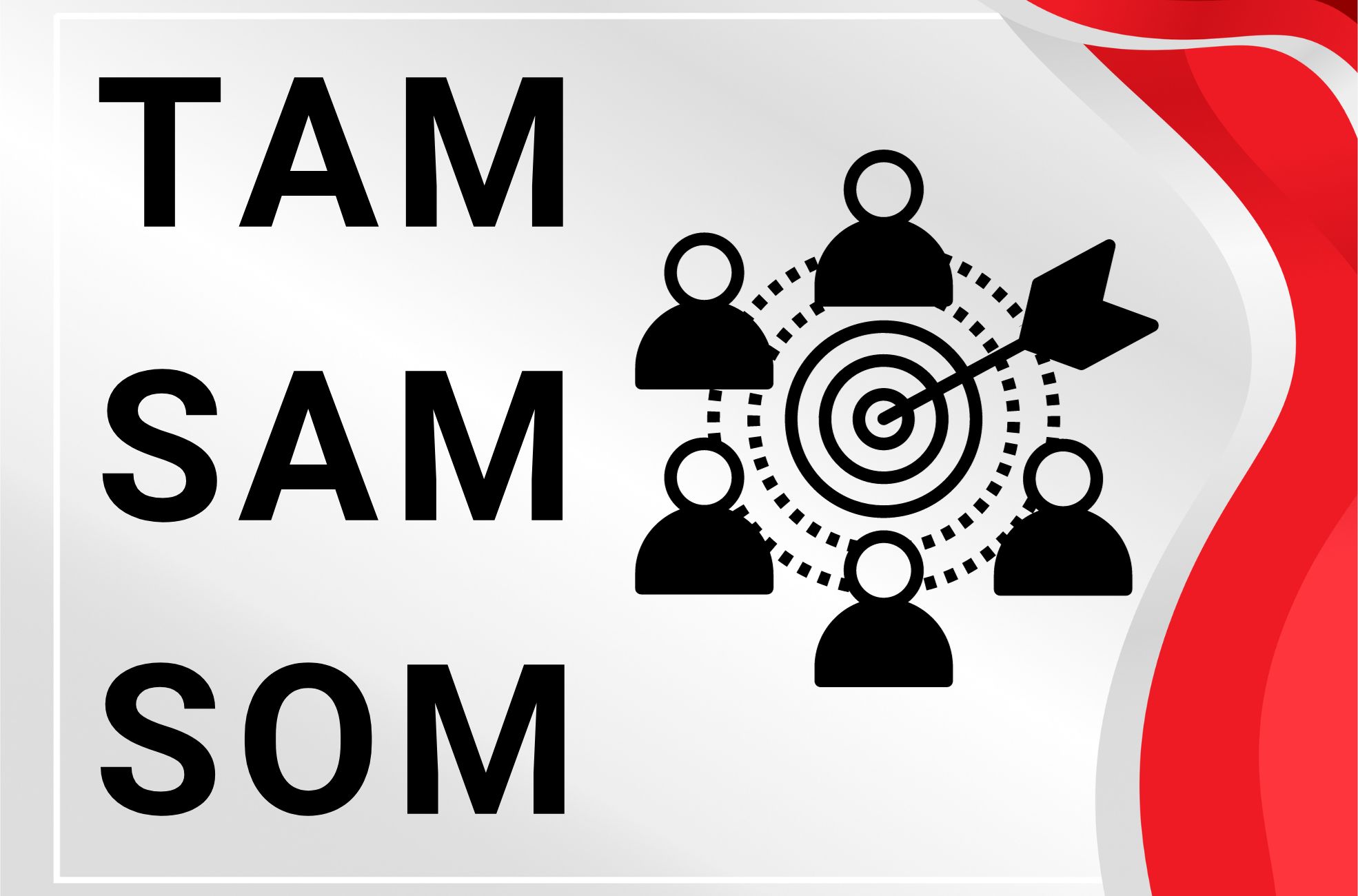Do you want your startup to capture the lion’s share of the market? Getting to know TAM, SAM, and SOM is your roadmap to realising that aspiration. In the hustle of entrepreneurship, these three acronyms distinguish a well-targeted effort from a shot in the dark. Understanding the scope of your Total Addressable Market (TAM), Serviceable Addressable Market (SAM), and Serviceable Obtainable Market (SOM) can mean the difference between a sustainable business and a fleeting venture.
We explain how TAM ,SAM, SOM can help you harness the full potential of your market presence and focus on the segments you can realistically conquer. Learn why investors pay close attention to these metrics and how they can signal your startup’s capacity for success.
Introduction to Market Size Metrics
When exploring the realm of business markets, it’s crucial to understand the concept of market size metrics. These metrics are pivotal in grasping a product or service’s potential reach and revenue within a specific market. Market size isn’t just an estimate of the total population in a region or country; it refers to the number of potential buyers within a particular market segment. This distinction is vital for businesses as it directly influences strategy development, investment attraction, budgeting, and hiring plans.
The process of market sizing involves several steps, starting with defining the market and identifying the target customer. It extends to calculating market volume, which is the number of target customers multiplied by the penetration rate, and potential market value, which is the market volume multiplied by the product or service price. These calculations provide a foundation for estimating a business’s potential profitability and sustainability by revealing if there are enough potential customers to support sales and if the market is large enough to generate the desired annual revenue amount.
Market size metrics are dynamic and should be regularly reviewed and updated with new data and market conditions. This ongoing process helps businesses stay informed about market trends, customer preferences, and the competitive landscape, which are essential for making informed business decisions.
Importance of TAM, SAM, and SOM
Getting to know the acronyms TAM, SAM, and SOM is fundamental when evaluating a business market. These acronyms are Total Addressable Market, Serviceable Addressable Market, and Serviceable Obtainable Market. They represent different layers of market potential and are critical for assessing the viability of a product or business, especially when soliciting investors.
TAM is the broadest metric, indicating the maximum market size or potential revenue a business could generate if it achieved 100% market share. It’s a hypothetical scenario that assumes no competition exists, providing a vision of the ultimate growth and potential returns if the business plan is successful. SAM narrows this down to the market segment that can be served by a specific product or business model, focusing on niche and medium-term growth. On the other hand, SOM offers a more grounded perspective by showing the market share that a current business model can reasonably expect to capture in the next 3-5 years, considering factors like competition, pricing discrepancies, and other market-narrowing factors.
These metrics help in business planning, investor relationships, and resource management. They enable businesses to determine the competitiveness of their product, identify untapped customer segments, and provide a “worst-case scenario” for investors, thereby de-risking the investment. Accurate TAM, SAM, and SOM figures are more valuable than the largest possible numbers, as they provide a realistic and credible picture of the business’s potential.

How These Metrics Guide Business Strategy
TAM, SAM, and SOM aren’t just theoretical constructs; they’re practical tools that guide business strategy at every stage of growth. By quantifying the business opportunity, these metrics help in presenting the value of an idea and the target audience to teams and investors. They’re instrumental in shaping strategies for increasing SOM, such as defining the target market and value proposition, offering more value at a lower price, and investing in customer success.
Calculating these metrics requires advanced market research and historical data. The more research and data you have, the more precise your planning will be. For instance, TAM can be calculated by multiplying the total number of accounts in the market by the average annual revenue and contract value of those accounts. SAM can be determined using a top-down approach, relying on published market analysis, or a bottom-up analysis, using primary market research. SOM takes into account more specific factors, such as competition and pricing strategies.
Investors pay close attention to these metrics to assess the risk and upside potential of an investment opportunity. SAM helps them understand how a company plans to position itself against competitors. At the same time, SOM ensures they start seeing a return on their investment, even if it’s a small one. These metrics should be included in a business plan to demonstrate a thorough understanding of the market potential, target market, and strategies for capturing market share.
Defining the Boundaries of Market Analysis
Defining the boundaries of market analysis is a critical step in the process of evaluating TAM, SAM, and SOM. Market boundaries can be based on various factors such as product characteristics, sales in specific regions, technology, customer function, or level of production and distribution. These boundaries need to be redefined as markets evolve due to technological changes, market-oriented product development, price changes, supply constraints, and social, legal, or government trends.
Market segmentation is a related concept that divides the total market into distinct groups or segments based on common characteristics, needs, or behaviours. This segmentation helps refine SAM and SOM by identifying the specific portion of the entire market that a business can target and serve.
A value proposition is another key element differentiating a company’s product or service from competitors and creating value for customers. It is an integral part of defining the SAM and SOM, as it clarifies the unique benefits offered to the target market.
What Is TAM? (Total Addressable Market)
TAM Explained
TAM is the revenue opportunity available for a product or service if a company is the sole provider in its market. It’s an idealised figure that does not consider competitors’ presence.
Calculating TAM
To estimate TAM, one might use a top-down approach, which starts with broad industry data and refines it to applicable segments. Alternatively, a bottom-up approach calculates TAM by aggregating the potential sales across individual customer segments. The value theory method estimates the worth customers might assign to a product or service and their willingness to pay for it. External sources such as Gartner or IDC can also provide sector-specific TAM estimates.
The Role of TAM in Investment Decisions
For stakeholders assessing a company’s prospects, TAM is a key indicator of potential scalability and market entry viability. It can guide strategic choices, including the prioritisation of product development, market segments, and resource allocation. However, the number of customers who achieve the total dominance represented by TAM is unrealistic due to market competition and other limiting factors.
Examples of TAM in Different Industries
WeWork’s TAM in the workspace market for desk-based workers was estimated at $1.35 trillion, indicating the expansive market for their services. Similarly, Uber’s entry into the personal transportation sector broadened the TAM by increasing service accessibility. These examples demonstrate how TAM serves as an initial measure of market potential before considering the division of market share among competitors.

What Does SAM Mean In Business? (Serviceable Addressable Market)
Differentiating TAM and SAM
SAM is a subset of TAM, delineating the portion of the available market that a business can realistically target and serve with its existing solutions. While TAM is the total market demand, SAM is constrained by the company’s current product and service capabilities.
Approaches to Estimate SAM
SAM can be estimated through a top-down or bottom-up analysis or by leveraging third-party research. The top-down method filters TAM by relevant factors. At the same time, the bottom-up approach builds from specific data points such as existing sales and the growth potential of existing businesses. Industry reports can also provide valuable benchmarks for a more accurate estimation.
Factors Influencing SAM
The size of SAM is affected by operational geography, target demographics, competitors, product or service positioning, and regulatory environments. Economic conditions and global trends also shape the accessible market segment.
Strategic Implications of SAM for Market Entry
SAM informs strategic decisions regarding market entry and resource focus. It enables precise investment decisions, pricing models, and market approach tactics. SAM also indicates the business’s near-term growth potential and is a vital metric for investors assessing the medium-term prospects of a venture. It helps in crafting marketing and sales strategies for the most attainable market segments, optimising resource allocation and customer conversion.
What Does SOM Mean In Business? (Serviceable Obtainable Market)
SOM is the fraction of SAM that a company can expect to capture, considering its current business capabilities and market conditions. It reflects the practical constraints such as resource limitations and the presence of competitors.
SOM – The Immediate Market Opportunity
This metric is essential for establishing realistic sales goals and guiding operational choices. It quantifies the segment of SAM that is likely to become actual revenue, factoring in the effectiveness of sales and marketing efforts elsewhere, pricing structures, and market competition.
SOM vs. SAM: Understanding the Distinction
SOM is a more refined metric than SAM, representing the achievable customer base within the latter. It is a measure of the market share that is within reach, helping to ensure that growth projections are grounded in reality.
Strategies for Capturing SOM
To increase SOM, businesses must develop strategies that play to their strengths and effectively address the needs of their target market. This includes honing in on a well-defined customer base, creating a strong value proposition, and a serviceable available market by setting competitive prices. Building customer relationships and tailoring solutions are also vital for standing out in the market and securing a larger SOM.

Implementing TAM, SAM, SOM in Business Planning
Bridging the Metrics and Business Objectives
Incorporating TAM, SAM, and SOM into business planning is essential for aligning market size metrics with a company’s products and goals. Companies can align with medium-term business strategies by understanding the full potential of market presence through TAM and focusing on the segments that are attainable with current capabilities through SAM. SOM provides a more immediate target, useful for establishing short-term objectives and communicating with stakeholders about near-term growth prospects.
Incorporating these metrics into a business plan can help set achievable goals, manage resources efficiently, and bolster investor confidence by demonstrating a well-rounded grasp of the market.
Best Practices for Presenting Market Size to Stakeholders
Effectively communicating market size to stakeholders involves more than just presenting large figures; it requires an engaging and realistic narrative. When discussing TAM, stakeholders gain insight into the business’s ultimate potential. SAM provides a perspective on competitive positioning, and SOM offers a practical view of short-term achievements.
A combination of methods may be employed for calculating these metrics. A top-down approach might be used for TAM, starting with macroeconomic data to estimate the total number of potential customers. For SAM and SOM, a bottom-up approach, focusing on actual customer interactions and their spending capacity, can yield a more precise picture of market potential.
When sharing these figures, supporting them with solid evidence and clarifying the assumptions is important. This shows a deep market understanding and fosters trust by demonstrating that the other business owner’s projections are based on tangible data.
Limitations and Common Pitfalls
TAM, SAM, and SOM must be estimated with consideration for factors such as regulatory landscapes, cultural nuances, and competitive forces. Overlooking these can lead to inflated metrics. Additionally, these metrics should not be used in isolation but rather as part of a comprehensive market analysis and business strategy.
The data underpinning these metrics must be current and reliable, necessitating regular updates and adaptability to market changes. Furthermore, it’s crucial to present these metrics to emphasise their strategic value rather than just their numerical magnitude.
Future Trends in Market Size Analysis
Advancements in data analytics tools are set to enhance the accuracy of TAM, SAM, and SOM estimations, leading to more sophisticated global market evaluations. As businesses increasingly operate globally, understanding international market segments will become more critical, requiring advanced methods for calculating these metrics.
The trend is likely to shift towards more detailed, customer-centric bottom-up market sizing, which aids in understanding the present market and predicting future customer behaviour and preferences for go-to-market strategy. Integrating these refined metrics into a business strategy will be key to navigating market complexities effectively.
Harnessing Market Metrics for Success
Navigating the intricacies of market sizing with TAM, SAM, and SOM analysis provides a structured pathway to business clarity and investor confidence. Recognising each metric’s unique role—from visionary TAM to the practical tactics for capturing SOM—can be the linchpin in a company’s strategic planning and execution.
By iterating these metrics with precision and awareness of market dynamics, businesses set themselves up for informed decision-making, resource optimisation, and a more secure journey through the competitive landscape. Whether you’re a startup seeking to carve out your niche or an established venture looking to expand, the clear articulation and application of TAM, SAM, and SOM foster sustainable growth and fortify stakeholder trust. Embrace these acronyms as the compass that guides your enterprise’s charting of the vast marketplace seas.









